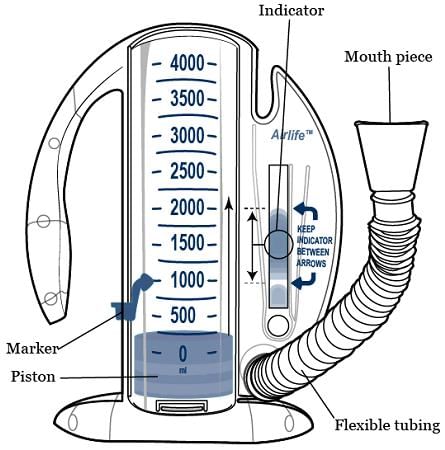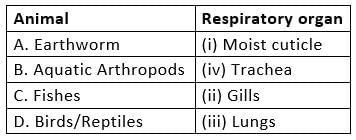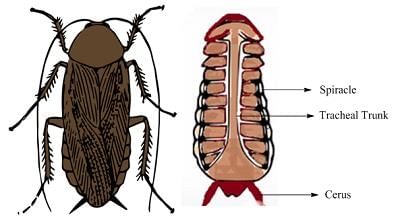NCERT Exemplars: Breathing & Exchange of Gases | Biology Class 11 - NEET PDF Download
| Table of contents |

|
| Multiple Choice Questions |

|
| Very Short Answer Type Questions |

|
| Short Answer Type Questions |

|
| Long Answer Type Questions |

|
Multiple Choice Questions
Q.1. Respiration in insects is called direct because
(a) The cell exchange O2/ CO2 directly with the air in the tubes.
(b) The tissues exchange O2/ CO2 directly with coelomic fluid.
(c) The tissues exchange O2/ CO2 directly with the air outside through body surface.
(d) Tracheal tubes exchange O2/ CO2 directly with the haemocoel which then exchanges with tissues.
Ans. (d)
Solution: Respiration in insects is called direct because tracheal tubes exchange O2/CO2 directly with the haemocoel which then exchanges with tissues.
Q.2. Regarding the functions of our respiratory system, mark the wrong entry.
(a) Humidifies the air
(b) Warms up the air
(c) Exchange of gases
(d) Cleans up the air
Ans. (c)
Q.3. A person suffers punctures in his chest cavity in an accident without any damage to the lungs. Its effect could be
(a) Reduced breathing rate
(b) Rapid increase in breathing rate
(c) No change in respiration
(d) Cessation of breathing
Ans. (d)
Solution: A person suffers punctures in his chest cavity in an accident, without any damage to the lungs, its effect could be a cessation of breathing.
Q.4. It is known that exposure to carbon monoxide is harmful to animals because
(a) It reduces CO2 transport
(b) It reduces O2 transport
(c) It increases CO2 transport
(d) It increases O2 transport
Ans. (b)
Solution: CO is a poisonous gas which binds with Hb more rapidly than O2 to form carboxyhaemoglobin. CO makes the most stable combination with the Hb of blood. CO has 200-250 times more affinity for Hb as compared to O2. When the inhaled air contains CO gas then a person suffers from suffocation because product cannot dissociate so decreases free oxygen. So it reduces O2 transport.
Q.5. Mark the true statement among the following with reference to normal breathing.
(a) Inspiration is a passive process whereas expiration is active
(b) Inspiration is an active process whereas expiration is passive
(c) Inspiration and expiration are active processes
(d) Inspiration and expiration are passive processes
Ans. (b)
Solution: The processes of inspiration (breathing in) and expiration (breathing out) are vital for providing oxygen to tissues and removing carbon dioxide from the body. Inspiration occurs via active contraction of muscles – such as the diaphragm – whereas expiration tends to be passive unless it is forced.
Q.6. A person breathes in some volume of air by forced inspiration after having a forced expiration. This quantity of air taken in is
(a) Total lung capacity
(b) Tidal volume
(c) Vital capacity
(d) Inspiratory capacity
Ans. (c)
Solution: Vital capacity is the maximum volume of air a person can breathe in after a forced expiration or the maximum volume of air a person can breathe out after a forced inspiration.
Q.7. Mark the incorrect statement in context to O2 binding to Hb
(a) Higher pH
(b) Lower temperature
(c) Lower pCO2
(d) Higher PO2
Ans. (a)
Solution: Binding of oxygen with haemoglobin is primarily related to partial pressure of O2. In alveoli, high pO2, low pCO2, less H+ concentration and lower temperature facilitate formation of oxyhaemoglobin.
Q.8. Mark the correct pair of muscles involved in the normal breathing in humans.
(a) External and internal intercostal muscles
(b) Diaphragm and abdominal muscles
(c) Diaphragm and external intercostal muscles
(d) Diaphragm and intercostal muscles
Ans. (d)
Solution: Diaphragm and intercostal muscles involved in the normal breathing in humans.
Q.9. Incidence of Emphysema – a respiratory disorder is high in cigarette smokers. In such cases
(a) The bronchioles are found damaged
(b) The alveolar walls are found damaged
(c) The plasma membrane is found damaged
(d) The respiratory muscles are found damaged
Ans. (b)
Solution: Emphysema is a chronic disorder in which alveolar walls are damaged due to which respiratory surface is decreased.
Q.10. The respiratory process is regulated by certain specialized centres in the brain. One of the following centres can reduce the inspiratory duration upon stimulation
(a) Medullary inspiratory centre
(b) Pneumotaxic centre
(c) Apneustic centre
(d) Chemosensitive centre
Ans. (b)
Solution: Pneumotaxic centre can reduce the inspiratory duration upon stimulation.
Q.11. CO2 dissociates from carbaminohaemoglobin when
(a) pCO2 is high & pO2 is low
(b) pO2 is high and pCO2 is low
(c) pCO2 and pO2 are equal
(d) None of the above
Ans. (b)
Solution: CO2 dissociates from carbaminohaemoglobin when pO2 is high and PCO2 is low.
Q.12. In breathing movements, air volume can be estimated by
(a) Stethoscope
(b) Hygrometer
(c) Sphygmomanometer
(d) Spirometer
Ans. (d)
Solution: In breathing movements, air volume can be estimated by the spirometer. SpirometerQ.13. From the following relationships between respiratory volume and capacities and mark the correct answer.
SpirometerQ.13. From the following relationships between respiratory volume and capacities and mark the correct answer.
(i) Inspiratory capacity (IC) = Tidal Volume + Residual Volume
(ii) Vital Capacity (VC) = Tidal Volume (TV) + Inspiratory Reserve Volume (IRV) + Expiratory Reserve Volume (ERV).
(iii) Residual Volume (RV) = Vital Capacity (VC) – Inspiratory Reserve Volume (IRV)
(iv) Tidal Volume (TV) = Inspiratory Capacity (IC) – Inspiratory Reserve Volume (IRV)
Options:
(a) (i) Incorrect, (ii) Incorrect, (iii) Incorrect, (iv) Correct
(b) (i) Incorrect, (ii) Correct, (iii) Incorrect, (iv) Correct
(c) (i) Correct, (ii) Correct, (iii) Incorrect, (iv) Correct
(d) (i) Correct, (ii) Incorrect, (iii) Correct, (iv) Incorrect
Ans. (b)
Q.14. The oxygen - haemoglobin dissociation curve will show a right shift in case of
(a) High pCO2
(b) High pO2
(c) Low pCO2
(d) Less H+ concentration
Ans. (a)
Solution: Curve shift is right in following conditions:
(1) Decrease in pO2
(2) Increase in pCO2 (Bohr effect)
(3) Increase in body temperature
(4) Increase in H+ ion concentration
(5) Decrease in pH
(6) Increase in 2, 3 diphosphoglycerate.
Q.15. Match the following and mark the correct options
Options:
a. A-ii, B-i, C-iv, D-iii
b. A-i, B-iv, C-ii, D-iii
c. A-i, B-iii, C-ii, D-iv
d. A-i, B-ii, C-iv, D-iii
Ans. (d)
Solution: 
- The worm's skin is protected by a thin cuticle and kept moist by a slimy mucus. This lets it absorb the oxygen it needs and expel carbon dioxide.
- Respiration in fish takes place with the help of gills. Most fish possess gills on either side of their head.
- The bird's respiratory system consists of paired lungs, which contain static structures with surfaces for gas exchange, and connected air sacs, which expand and contract causing air to move through the static lungs.
- All reptiles breathe through their lungs.
Very Short Answer Type Questions
Q.1. Define the following terms?
(a) Tidal volume
(b) Residual volume
(c) Asthma
Ans. (a) Tidal volume: Volume of air inspired or expired during normal respiration. It is approx. 500 mL, i.e., a healthy man can inspire or expire approximately 6000 to 8000 mL of air per minute.
(b) Residual volume: Volume of air remaining in the lungs even after a forcible expiration. This averages 1100 mL to 1200 mL. Residual air mainly occurs in alveoli.
(c) Asthma: Asthma is a difficulty in breathing causing wheezing due to inflammation of bronchi and bronchioles. In asthma, due to flattening of tracheal vessels, alveoli are deprived of oxygen. Asthma is characterised by spasm in the bronchial muscle.
Q.2. A fluid-filled double membranous layer surrounds the lungs. Name it and mention its important function.
Ans. Pleural fluid is found in between the two membranes of lung and it reduces the friction on the lung surface.
Q.3. Name the primary site of exchange of gases in our body?
Ans. Alveoli
Q.4. Cigarette smoking causes emphysema. Give reason
Ans. Cigarette smoking causes the damage of the alveolar walls leading to decreased respiratory surfaces for exchange of gases.
Q.5. What is the amount of O2 supplied to tissues through every 100 ml. of oxygenated blood under normal physiological conditions?
Ans. 5 mL of oxygen/100 mL of oxygenated blood.
Q.6. A major percentage (97%) of O2 is transported by RBCs in the blood. How does the remaining percentage (3%) of O2 transport?
Ans. Through Plasma.
Q.7. Arrange the following terms based on their volumes in an ascending order
(a) Tidal Volume (TV)
(b) Residual Volume (RV)
(c) Inspiratory Reserve Volume (IRV)
(d) Expiratory Capacity (EC)
Ans. (a) Tidal Volume (TV): 500 mL
(b) Residual Volume (RV): 1100 mL-200 mL
(c) Inspiratory Reserve Volume (IRV): 2500 mL-3000 mL
(d) Expiratory Capacity (EC): 1500 mL-1600 mL
(a) TV< (b) RV< (d) EC< (c) IRV
Q.8. Complete the missing terms
(a) Inspiratory Capacity (IC) = _____ +IRV
(b) ___________________ = TV + ERV
(c) Functional Residual Capacity (FRC) = ERV + ____
Ans. (a) Inspiratory Capacity (IC) = TV + IRV
(b) EC = TV + ERV
(c) Functional Residual Capacity (FRC) = ERV + RV
Q.9. Name the organs of respiration in the following organisms:
(a) Flatworm - ________
(b) Birds - ________
(c) Frog- ________
(d) Cockroach - ________
Ans. (a) Flatworm—Entire body surface Flatworm(b) Birds—Lung
Flatworm(b) Birds—LungBird(c) Frog—Lung and moist skin
 Frog(d) Cockroach—Tracheal tubes
Frog(d) Cockroach—Tracheal tubes Cockroach
Cockroach
Q.10. Name the important parts involved in creating a pressure gradient between the lungs and the atmosphere during normal respiration
Ans. Diaphragm and Intercostal muscles
Short Answer Type Questions
Q.1. State the different modes of CO2 transport in blood.
Ans. Nearly 20-25% of CO2 by RBCs
Nearly 70% of CO2 as bicarbonates.
Nearly 7% of CO2 as dissolved state in plasma.
Q.2. Compared to O2, the diffusion rate of CO2 through the diffusion membrane per unit difference in partial pressure is much higher. Explain.
Ans. Solubility is an important factor deciding diffusion rate. As the solubility of CO2 is 20-25 times higher than O2, diffusion of CO2 through the diffusion membrane per unit difference in partial pressure is much higher.
Q.3. For completion of respiration process, write the given steps in sequential manner
(a) Diffusion of gases (O2 and CO2) across alveolar membrane.
(b) Transport of gases by blood.
(c) Utilisation of O2 by the cells for catabolic reactions and resultant release of CO2.
(d) Pulmonary ventilation by which atmospheric air is drawn in and CO2 rich alveolar air is released out.
(e) Diffusion of O2 and CO2 between blood and tissues.
Ans. Following is the correct sequence:
(a) Diffusion of gases (O2 and CO2) across the alveolar membrane.
(b) Transport of gases by blood.
(c) Utilisation of O2 by the cells for catabolic reactions and resultant release of CO2.
(d) Pulmonary ventilation by which atmospheric air is drawn in and CO2 rich alveolar air is released out.
(e) Diffusion of O2 and CO2 between blood and tissues.
Q.4. Differentiate between
(a) Inspiratory and expiratory reserve volume
(b) Vital capacity and total lung capacity
(c) Emphysema and occupational respiratory disorder
Ans. (a) The additional volume of air a person can inspire by a forcible inspiration is called inspiratory reserve volume (IRV). The additional volume of air a person can expire by a forced expiration is called expiratory reserve volume (ERV). In a normal individual, IRV is about 2500 to 3000 mL while ERV is about 1000 to 1100 mL.
(b) The maximum volume of air a person can breathe in after a forced expiration, or the maximum volume of air a person can breathe out after a forced inspiration is called Vital Capacity. The total volume of air in the lungs at the end of a forced inspiration is called Total Lung Capacity.
(c) Alveoli walls are damaged in emphysema, while any other part of the respiratory system could be damaged in occupational respiratory disorder. Smoking is a major cause of emphysema. Fine particles generated during some mechanical processes are the cause of the occupational respiratory disorder.
Long Answer Type Questions
Q.1. Explain the transport of O2 and CO2 between alveoli and tissue with a diagram.
Ans. (i) Transport of gases: Blood is the medium of transport for O2 and CO2. About 97% of O2 is transported by RBCs in the blood. The remaining 3% of O2 is carried in a dissolved state through the plasma. Nearly 20-25% of CO2 is transported by RBCs whereas 70% of it is carried as bicarbonate. About 7% of CO2 is carried in a dissolved state through plasma.
(ii) Transport of oxygen: Haemoglobin is a red coloured iron-containing pigment present in the RBCs. O2 can bind with haemoglobin in a reversible manner to form oxyhaemoglobin. Each haemoglobin molecule can carry a maximum of four molecules of O2.
- Binding of oxygen with haemoglobin is primarily related to the partial pressure of O2. The partial pressure of CO2, hydrogen ion concentration and temperature are the other factors which can interfere with this binding. A sigmoid curve is obtained when the percentage saturation of haemoglobin with O2 is plotted against the PO2. This curve is called the Oxygen dissociation curve and is highly useful in studying the effect of factors like PCO2, H+ concentration, etc., on the binding of O2 with haemoglobin.
- In the alveoli, where there is high pO2, low pCO2, lesser H+ concentration and lower temperature, the factors are all favourable for the formation of oxyhaemoglobin, whereas in the tissues, where low pO2, high pCO2, high H+ concentration and higher temperature exist, the conditions are favourable for dissociation of oxygen from the oxyhaemoglobin. This clearly indicates that O2 gets bound to haemoglobin in the lung surface and gets dissociated at the tissues. Every 100 ml of oxygenated blood can deliver around 5 mL of O2 to the tissues under normal physiological conditions.
(iii) Transport of carbon dioxide: CO2 is carried by haemoglobin as carbamino-haemoglobin (about 20-25%). This binding is related to the partial pressure of CO2. pO2 is a major factor which could affect this binding. When pCO2 is high and pO2 is low as in the tissues, more binding of carbon dioxide occurs whereas, when the pCO2 is low and pO2 is high as in the alveoli, dissociation of CO2 from carbamino-haemoglobin takes place, i.e., CO2 which is bound to haemoglobin from the tissues is delivered at the alveoli. RBCs contain a very high concentration of the enzyme, carbonic anhydrase and minute quantities of the same is present in the plasma too. This enzyme facilitates the following reaction in both directions.
At the tissue site where partial pressure of CO2 is high due to catabolism, CO2 diffuses into blood (RBCs and plasma) and forms HCO2 and H+. At the alveolar site where pCO2 is low, the reaction proceeds in the opposite direction leading to the formation of CO2 and H2O. Thus, CO2 trapped as bicarbonate at the tissue level and transported to the alveoli is released out as CO2. Every 100 mL of deoxygenated blood delivers approximately 4 mL of CO2 to the alveoli.
 Exchange of gases at the alveolus and the body tissues with blood and transport of oxygen and carbon dioxideQ.2. Explain the mechanism of breathing with neatly labelled sketches.
Exchange of gases at the alveolus and the body tissues with blood and transport of oxygen and carbon dioxideQ.2. Explain the mechanism of breathing with neatly labelled sketches.
Ans. Breathing involves two stages:
(a) Inspiration: Inspiration is initiated by the contraction of the diaphragm, which increases the volume of thoracic chamber in the anteroposterior axis. The contraction of external intercostal muscles lifts up the ribs and the sternum causing an increase in the volume of thoracic chamber in the dorso-ventral axis also. Such an increase in thoracic volume leads to a similar increase in pulmonary volume resulting in decreased intra- pulmonary pressure to less than atmospheric pressure. This causes the movement of external air into the lungs, i.e., inspiration.
(b) Expiration: The inter-costal muscles return the diaphragm and sternum to their normal positions with relaxation of the diaphragm. This reduces the thoracic volume and thereby the pulmonary volume. As a result, an increase in intra-pulmonary pressure to slightly above the atmospheric pressure causes the expulsion of air from the lungs i.e., expiration.
Q.3. Explain the role of the neural system in the regulation of respiration.
Ans. Human beings have a significant ability to maintain and moderate the respiratory rhythm to suit the demands of the body tissues. This is done by the neural system.
- A specialised centre present in the medulla region of the brain called respiratory rhythm centre is primarily responsible for this regulation. Another centre present in the pons region of the brain called pneumatic centre can moderate the functions of the respiratory rhythm centre. The neural signal from this centre “can reduce the duration of inspiration and thereby alter the respiratory rate.
- A chemosensitive area is situated adjacent to the rhythm centre which is highly sensitive to CO2 and hydrogen ions. Increase in these substances can activate this centre, which in turn can signal the rhythm centre to make necessary adjustments in the respiratory process by which these substances can be eliminated. Receptors associated with aortic arch and carotid artery also can recognise changes in CO2 and H+ concentration and send necessary’ signals to the rhythm centre for remedial actions. The role of oxygen in the regulation of respiratory rhythm is quite insignificant.
|
150 videos|398 docs|136 tests
|
FAQs on NCERT Exemplars: Breathing & Exchange of Gases - Biology Class 11 - NEET
| 1. What is the process of breathing and exchange of gases? |  |
| 2. How does oxygen reach body tissues from the lungs? |  |
| 3. What happens during inhalation and exhalation? |  |
| 4. How is the exchange of gases facilitated in the alveoli? |  |
| 5. What factors can affect the efficiency of breathing and gas exchange? |  |





















